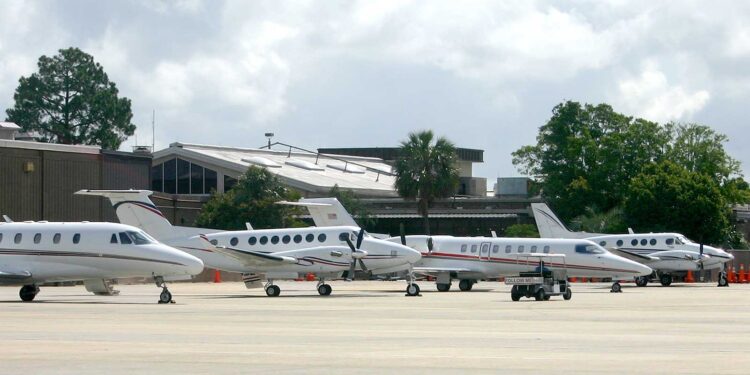Permits & Slot Flexibility Worldwide – Part 1: Permit Considerations

This business aviation blog post is part of a series on permit and slot flexibility concerns.
Overflight and landing permits are needed for many international locations and regions, all with varying lead time, procedural and documentation requirements. To avoid potential pitfalls on the day of operation, it’s important to understand the various requirements and nuances involved with all applicable permit scenarios.
The following is an overview of what you need to know:
1. Information required for permits
To request landing or overflight permits you’ll need to provide a schedule, clear, valid and correct aircraft documentation, complete crew and passenger details and in many cases pilot licenses and pilot medical certificates.
2. Lead time considerations
When landing permits are required, lead times can range from less than 24 hours to 45 days. One week lead time is usually sufficient for private non-revenue operations and two weeks’ notice is recommended for charter permits. However, lead times may be longer when large events are taking place at the destination. It’s important to be aware of CAA processing hours as many of them are usually close on weekends and holidays. And, be mindful that weekends can vary and are often Friday and Saturday in the Middle East.
3. German charter permits
The German Civil Aviation Authority (CAA) is particularly stringent on lead times but also on specific documentation mandates. Be aware that Germany will not process short notice charter landing permit requests. Quite a number of documents need to be submitted with German permit requests. If there’s any missing information or errors in the document submission, the application will be delayed.
4. Permits for China
While lead time for China permits is now down to just three business days, it’s important to consider all permit requirements as well as limitations on permit revisions. China is particularly strict on limiting permit revisions to a maximum of two. After you’ve made two revisions you’ll need to start another landing permit request from the beginning. China permits will not be approved if you do not provide a sponsor letter from a local business contact.
5. Cuba permits
Regulations for U.S. registered aircraft has eased over the last few years, but operators still need to ensure that they meet the requirements when traveling to and from Cuba. Though regulations have eased, they could change at a moment’s notice, so operators should speak to their trip support provider prior to any travel to the country.
6. Venezuela permits
If you’re planning to stay in Venezuela more than 72 hours, plan on 30 business days lead time for landing permits. In some cases, permits are possible with less notice but this is at discretion of CAA. The permit process for Venezuela is not easy as required documentation needs to be translated into Spanish, apostilled, and have the original documents delivered to CAA via courier. Another issue to consider are outstanding nav fees. If nav fees are owned to Venezuela you will not obtain overflight rights and may need to divert around the country. It’s not always straight-forward determining if fees are outstanding and there are often issues in terms of making payment for outstanding charges in a timely manner.
7. Charter permits for France
Special requirements and lead time considerations apply for French charter (non-scheduled commercial) permits. Operators must submit, a Foreign Operator Questionnaire (FOQ). Depending on information submitted in your FOQ you may need to provide additional documentation and this could delay permit approval.
8. Charter operations to Italy
If you’ve not operated to Italy as a charter during the past two IATA seasons, lead time to obtain a charter permit, as per Ente Nazionale per l’Aviazione Civile (ENAC) requirements is 45 days. It’s always important to check lead times and feasibility of permits when you have short notice trips as some countries like Italy have extended permit lead times.
9. Easier permit options
In some regions, permits are relatively easy to obtain. For example, for much of Central America CENAMER permits are just a notification and there are rarely issues unless operators have unpaid fees outstanding. When operating to Poland as a private non-revenue flight, a landing permit is a notification only, with an application, noise and insurance certificates submitted. Overflight permits for Turkey are usually also just notification. For more information on permits for Turkey see our articles:
- Turkey Overflight Permit Changes – Part 1: Good News for Bizav
- Turkey Overflight Permit Changes – Part 2: Processing Permit Exemptions
10. Unique permit requirements
Here and there you’ll run across unique and idiosyncratic permit and slot requirements. For example, Colombia wants your engine and emergency locator transmitter (ELT) serial numbers for an overflight permit. The Philippines mandates that operators provide a color photo of the aircraft showing tail number. For a Kenyan landing permit you’ll need to provide maintenance logs. Meanwhile, Singapore needs a current maintenance release and aging aircraft compliance from the state of registry of the aircraft.
Conclusion
It’s important to be aware of permit requirements for all intended destinations and ensure your 3rd-party provider has up-to-date, valid and correct documentation on file for your aircraft and operation. Be mindful that multiple revisions to approved permits may require you to begin the permit application all over again from scratch. Also, short notice permits may not be an option for your trip so a feasibility check is always recommended.
Later, we’ll discuss slot considerations for your next trip.
Questions?
If you have any questions about this article or would like assistance planning your next trip, contact me at stephenbober@univ-wea.com.



